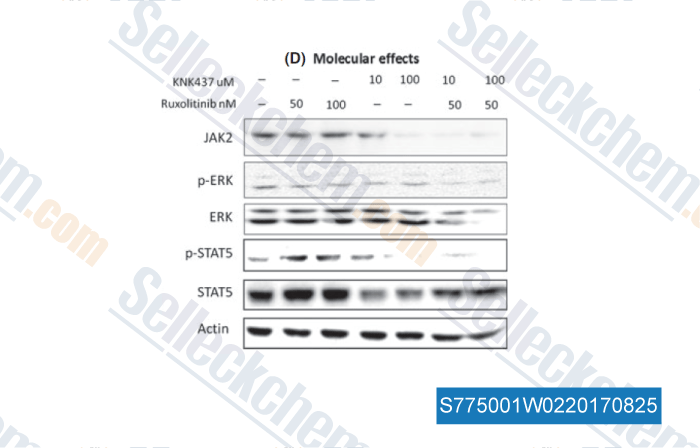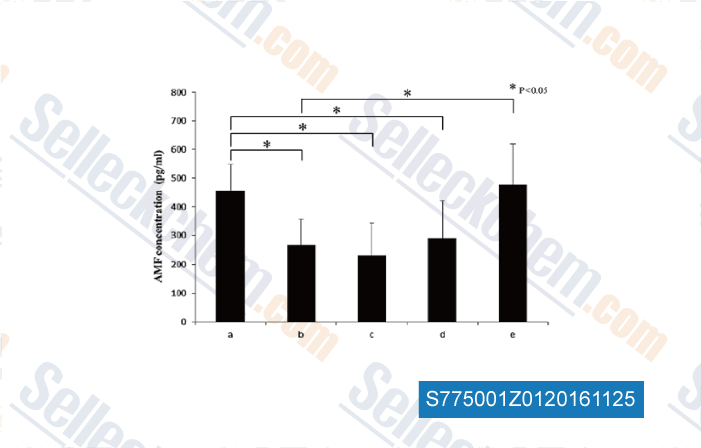|
Toll Free: (877) 796-6397 -- USA and Canada only -- |
Fax: +1-832-582-8590 Orders: +1-832-582-8158 |
Tech Support: +1-832-582-8158 Ext:3 Please provide your Order Number in the email. |
Technical Data
| Formula | C13H11NO4 |
||||||||||
| Molecular Weight | 245.23 | CAS No. | 218924-25-5 | ||||||||
| Solubility (25°C)* | In vitro | DMSO | 17 mg/mL (69.32 mM) | ||||||||
| Water | Insoluble | ||||||||||
| Ethanol | Insoluble | ||||||||||
| In vivo (Add solvents to the product individually and in order) |
|
||||||||||
|
* <1 mg/ml means slightly soluble or insoluble. * Please note that Selleck tests the solubility of all compounds in-house, and the actual solubility may differ slightly from published values. This is normal and is due to slight batch-to-batch variations. * Room temperature shipping (Stability testing shows this product can be shipped without any cooling measures.) |
|||||||||||
Preparing Stock Solutions
Biological Activity
| Description | KNK437 is a pan-HSP inhibitor, which inhibits the synthesis of inducible HSPs, including HSP105, HSP72, and HSP40. | |||
|---|---|---|---|---|
| Targets |
|
|||
| In vitro | KNK437 dose-dependently inhibits the acquisition of thermotolerance and the induction of various HSPs including HSP105, HSP70, and HSP40 in COLO 320DM (human colon carcinoma) cells.[1] KNK437 and quercetin inhibits thermotolerance in a dose-dependent manner in PC-3 cells. KNK437 decreases heat-induced accumulation of Hsp70 mRNA and protein in PC-3 and LNCaP cells.[2] | |||
| In vivo | KNK437 (200 mg/kg, i.p.) shows no antitumor effects and does not increase the thermosensitivity of nontolerant tumors. The same dose of KNK437 enhances the antitumor effects of fractionated heat treatment in a synergistic manner.[3] |
Protocol (from reference)
| Kinase Assay:[1] |
|
|---|---|
| Cell Assay:[1] |
|
| Animal Study:[3] |
|
References
|
Customer Product Validation

-
Data from [Data independently produced by , , Br J Haematol, 2013, 161(5):667-76]

-
Data from [Data independently produced by , , ONCOLOGY REPORTS, 2012, 28:1953-1958.]
Selleck's KNK437 has been cited by 4 publications
| A potential role for Giardia chaperone protein GdDnaJ in regulating Giardia proliferation and Giardiavirus replication [ Parasit Vectors, 2023, 16(1):168] | PubMed: 37226181 |
| Activation of the IL-1β/KLF2/HSPH1 pathway promotes STAT3 phosphorylation in alveolar macrophages during LPS-induced acute lung injury. [ Biosci Rep, 2020, 40(3)] | PubMed: 32091104 |
| Inhibition of related JAK/STAT pathways with molecular targeted drugs shows strong synergy with ruxolitinib in chronic myeloproliferative neoplasm. [Barrio S, et al. Br J Haematol, 2013, 161(5):667-76] | PubMed: 23560534 |
| Hyperthermia reduces migration of osteosarcoma by suppression of autocrine motility factor. [Nakajima K, et al. Oncol Rep, 2012, 28(6):1953-8] | PubMed: 23027359 |
RETURN POLICY
Selleck Chemical’s Unconditional Return Policy ensures a smooth online shopping experience for our customers. If you are in any way unsatisfied with your purchase, you may return any item(s) within 7 days of receiving it. In the event of product quality issues, either protocol related or product related problems, you may return any item(s) within 365 days from the original purchase date. Please follow the instructions below when returning products.
SHIPPING AND STORAGE
Selleck products are transported at room temperature. If you receive the product at room temperature, please rest assured, the Selleck Quality Inspection Department has conducted experiments to verify that the normal temperature placement of one month will not affect the biological activity of powder products. After collecting, please store the product according to the requirements described in the datasheet. Most Selleck products are stable under the recommended conditions.
NOT FOR HUMAN, VETERINARY DIAGNOSTIC OR THERAPEUTIC USE.
